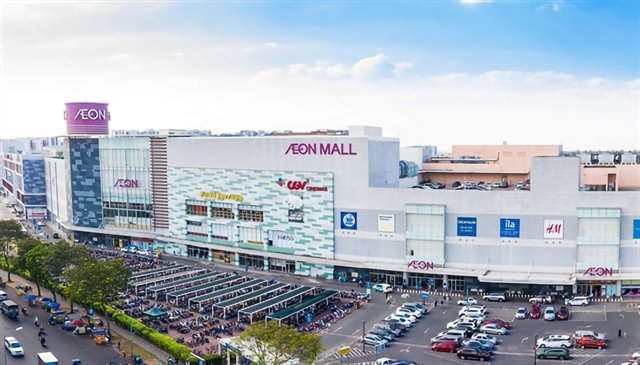 Economy
Economy

Foreign retail businesses are adopting a multi-channel sales strategy as well as improved operations and delivery services to expand Việt Nam operations despite pandemic impacts.

|
| The Tân Phú Celadon shopping mall in HCM City. Pandemic impacts have prompted foreign retail businesses in Việt Nam to diversify the sales channels and improve customer service. — Photo courtesy of AEON Vietnam |
HCM CITY — Foreign retail businesses are adopting a multi-channel sales strategy as well as improved operations and delivery services to expand Việt Nam operations despite pandemic impacts.
Huỳnh Lê Minh Tú, deputy director of the HCM City Department of Industry and Trade, said that with a population of more than 90 million and increasing living standards, the retail market will remain very attractive for foreign investors in Việt Nam.
“Foreign retailers optimising the shopping experience for customer retention and applying multiple sales process metrics will have a better edge to dominate the market,” he said.
Given the digital transformation trend in the retail sector, many foreign retail businesses are constantly improving their technological applications for collection, storage, management and comprehensive data analysis, based on a solid, secure, flexible and self-operating cloud computing infrastructure, he said.
Other observers have also remarked that the fourth wave of COVID-19 has pushed foreign retailers to diversify their sales channels instead of the usual primary focus on providing goods onsite to consumers.
Last year, major retailers like MM Mega Market Vietnam, Central, Aeon, LOTTE Mart and Emart implemented cashless payment methods for both online and offline shopping.
MM Mega Market Vietnam has started a multi-channel sales development strategy alongside completing its online sales solutions: website MM Click & Get; Zalo and Telesales.
It also plans to launch an online shopping website for professionals with product prices and solutions designed for each specific customer.
With the pandemic situation remaining unpredictable this year, foreign retail businesses will need to be well prepared so they can keep pace with the nation’s economic recovery, experts have said.
MM said it will continue to invest and develop multi-channel sales, with its wholesale supermarket system implementing the Pick & Go software soon.
Multiple outlets
Meanwhile, AEON Việt Nam has said it would open more outlets in different locations with a variety of retail models, including shopping malls, department stores, supermarkets, convenience stores and specialised stores.
As it does this, it will maintain its digital transformation process, especially focusing on promoting O2O (offline-to-online); developing products to meet customer needs and do more to boost sustainable development by promoting environmental protection and social responsibility.
Furusawa Yasuyuki, general director of AEON Việt Nam, said they aim to open 30 shopping centres by 2030 along with other models.
South Korean Emart Vietnam Co., Ltd. (acquired by the Thaco Group) will put into operation two new shopping centres.
Hirai Shinji, chief representative of the Japan External Trade Organisation (JETRO) in Việt Nam, said the Vietnamese retail market remains very attractive for Japanese investors.
Despite the impacts of the pandemic, retailers and non-manufacturing enterprises from Japan are expanding their business in Việt Nam to take advantage of its young population and an increase in per capita income, he added.
A recent JETRO survey found more than 55 per cent of Japanese firms intend to expand their business in Việt Nam.
According to the survey, conducted from August to September last year, more than 56 per cent of the firms expect higher profits this year, and only 9.6 per cent think their profit will reduce.
Modern retail distribution has faced huge hurdles over the last two years due to the pandemic impacts (changes in customer trends, human resources, warehouse operations and supply chain disruptions).
Although the Việt Nam retail market experienced a low growth rate due to the pandemic last year, it remains a market with high long-term potential, experts have said.
They have noted that over the next five to 10 years, the country will be a leader in Southeast Asia in terms of an expanding middle class, which is expected to grow by around 9.2 per cent every year. — VNS




